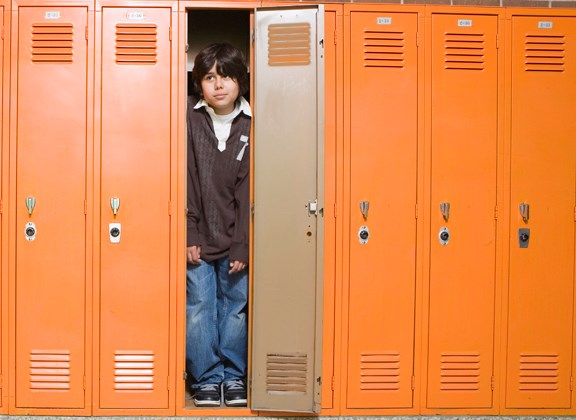The kids were excited. They don't watch a lot of TV but they have a few favourite programs that their parents tape for them to watch. And it was time.
Their grandpa and I were watching them and we fired up the TV and selected an episode. We immediately knew that this particular edition of the show was a mistake. Coming over a hill in the scary moonlight was a seriously frightening monster truck! We quickly turned off the program but they had both seen the scene. One child shrugged and walked away. Her brother however started to howl. He was terrified. His sister said, "It's OK, it's only a movie" but his brother would have nothing to do with that.
We assured him that Grandpa had erased the show, that it was gone. Throughout the evening we needed to reassure him often, and to no one's surprise he had nightmares that night.
Different kids, different responses. But fears are pretty typical among the toddler and preschool set.
Babies have no demands made on them, but once they can follow simple directions, can walk and are starting to talk they have expectations put on them.
This is an important part of growing up but it also means that the kids become aware of their limitations and that there may be dangers in their world. Adding to the usual child fears, today's kids are also seeing the terrorist attacks in France and elsewhere on TV and hearing their parents' conversations about ISIL and ISIS. This is a challenge for parents because we also have no real answers but we need to address our kids' fears.
The first thing to do is to turn off the TV and watch the news after the kids are in bed. The images on the screen come at them fast and furious. They cannot take the time to process what is happening.
If they are worried, reassure them that they will be safe, that you will look after them.
If your children are older, talk about what's happening in language they can understand but don't overwhelm them. One of the scariest things about these fears is the lack of control. So give the kids a way to get involved. Maybe they will work with the local church that is sponsoring a refugee family, they can befriend a new child in their classroom or they can donate clothing and toys to the appropriate organization. Typical kids fears are a result of the fact that this is also when their imaginations start to develop. They can look beyond what is right in front of them and imagine a monster under the bed or they can recall a scary moment (the monster truck) and become frightened again. What can we do?
This little boy's mother has recently given him control of his imagination. On a future visit he explained to us that he could use his imagination to make scary things go away. Once he knew he had control, his fear diminished.
Toddlers are great copycats so if Mom screams every time she sees a spider the child quickly learns that spiders are to be feared.
Sometimes a negative experience can turn into an ongoing fear. When my daughter was 10 months old she spent a week in the hospital. After she was home our doctor said I should bring her in with me for prenatal check-ups and he would essentially ignore her at first. The reason, he explained, is that she had developed a fear of "white coats" and needed to experience some visits to the doctor that were non-intrusive. After a couple of visits she was keen to see him and her fears disappeared.
As our children become more mobile and active it's easy for us to be constantly warning them about possible dangers. "Don't touch that stick, it's sharp, don't climb on that rock, you could fall, be careful." If we are constantly warning them, they can start to see he world as a pretty dangerous place and be concerned about their inability to keep themselves safe.
Yes, we need to teach them how to be safe, but we can be positive by showing them how to protect themselves. "Look! The rock is slippery on that side but I bet you can climb up the other way. Let me show you how to play with a stick and not hurt yourself."
Toddlers' and preschoolers' fears are pretty typical behaviours. They need us to be on their side. It's not helpful to say, "Oh, don't worry you'll be fine." Let them know that you appreciate their fear and then work with them at their pace to get past it.
If the fear is of dogs you might start with pictures, then watching dogs on the other side of a fence. If he wants to leave in a few seconds that's OK.
A slow gradual approach that respects the child's ability to move forward is more likely to be successful.
Kathy Lynn is a professional speaker and author of Vive la Différence, Who's In Charge Anyway? and But Nobody Told Me I'd Ever Have to Leave Home. Sign up for her informational newsletter at parentingtoday.ca.



